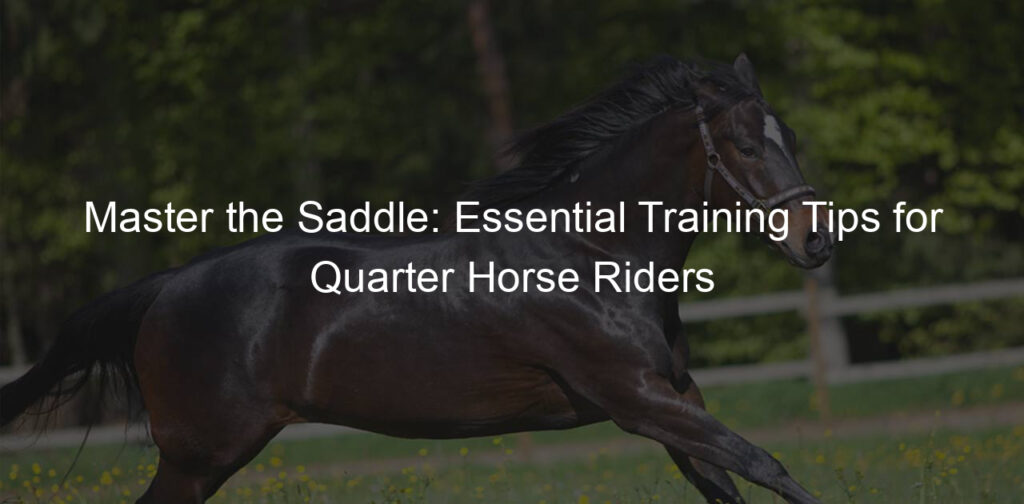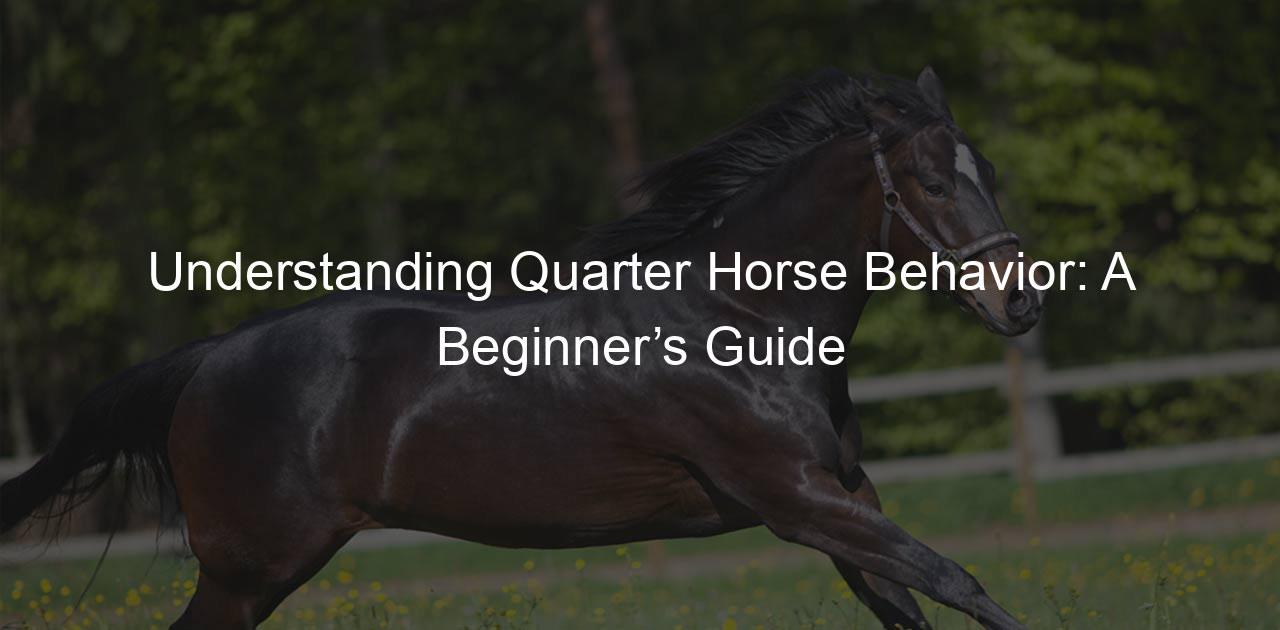Introduction to Quarter Horse Training
Training a Quarter Horse is a rewarding experience that requires patience, dedication, and a deep understanding of these magnificent creatures. In this section, we will delve into the basics of Quarter Horse training and highlight the importance of proper training for riders.
- Understanding the Basics of Quarter Horse Training
- Importance of Proper Training for Quarter Horse Riders
The Quarter Horse, named for its exceptional speed over a quarter of a mile, is a versatile breed known for its agility, intelligence, and docility. Training a Quarter Horse involves a series of steps that start from the ground up. The first step is establishing trust and respect between the horse and the handler. This is achieved through groundwork exercises that involve leading, lunging, and desensitizing the horse to various stimuli.
Once a solid foundation of trust and respect is established, the next step is to introduce the horse to riding equipment such as the saddle, bridle, and bit. This is followed by basic riding exercises that teach the horse to respond to the rider’s cues for walking, trotting, cantering, and stopping.
Training a Quarter Horse is not a one-size-fits-all process. Each horse is unique and requires a tailored approach based on its temperament, physical abilities, and past experiences. Therefore, it’s essential for the trainer to be patient, observant, and adaptable.
Proper training is not only crucial for the horse but also for the rider. A well-trained rider is able to communicate effectively with the horse, ensuring a harmonious and safe riding experience. Rider training involves learning how to give clear and consistent cues, maintaining a balanced seat, and understanding horse behavior.
Furthermore, proper rider training can prevent common riding mistakes that can confuse or frustrate the horse, such as inconsistent cues, poor timing, and lack of balance. By investing in proper training, riders can enhance their riding skills, build a strong bond with their horse, and ensure the horse’s well-being.
In conclusion, Quarter Horse training is a journey that involves understanding the horse’s nature, building a strong foundation of trust and respect, and mastering the art of effective communication. Whether you are a novice rider or an experienced equestrian, proper training is the key to a successful and enjoyable Quarter Horse riding experience.
Essential Horse Riding Tips
Whether you’re a novice rider or an experienced equestrian, there are certain tips that can help you improve your horse riding skills. In this section, we will focus on the preparation for horse riding, specifically for Quarter Horse breeds.
Preparation for Horse Riding
Before you even mount your horse, there are two crucial steps you need to take: choosing the right equipment and understanding your Quarter Horse’s behavior.
- Choosing the right equipment
- Understanding your Quarter Horse’s behavior
Having the right equipment is essential for a safe and enjoyable horse riding experience. This includes a properly fitting helmet, riding boots, and gloves. For the horse, you’ll need a suitable saddle and bridle. Remember, comfort is key for both you and your horse. Ill-fitting equipment can cause discomfort and even injuries. Always ensure that your equipment is in good condition before each ride.
Quarter Horses are known for their calm and steady temperament, making them ideal for riders of all levels. However, like all animals, they have their own unique personalities and behaviors. Spend time with your horse before riding. Observe their behavior, get to know their likes and dislikes. This will not only help you build a bond with your horse but also enable you to anticipate their reactions during the ride.
Preparation is the key to a successful horse riding experience. By choosing the right equipment and understanding your Quarter Horse’s behavior, you can ensure a safe and enjoyable ride.
During the Ride
Once you’re in the saddle, the real fun begins. Here are some crucial steps to ensure a smooth and enjoyable ride on your Quarter Horse.
- Mastering Quarter Horse Riding Techniques
- Maintaining Balance and Control
Quarter Horses are known for their agility and speed, making them perfect for various riding styles. However, mastering these techniques requires practice and patience. Start with the basics, like walking, trotting, and cantering. Once you’re comfortable with these, you can move on to more advanced techniques like galloping and jumping. Remember, every horse is unique, so what works for one might not work for another. Always be patient and consistent with your training. For more detailed information, you can refer to the American Quarter Horse Association’s guide.
Balance and control are crucial when riding any horse, but they’re especially important with Quarter Horses due to their speed and agility. To maintain balance, keep your weight centered and your body aligned with the horse’s movements. This will help you stay in sync with your horse and prevent any unnecessary strain on its back. Control, on the other hand, comes from effective communication. Use your hands, legs, and voice to guide your horse, but remember to be gentle. Rough handling can scare your horse and make it more difficult to control. For more tips on maintaining balance and control, check out this horse training guide.
Remember, riding a Quarter Horse is a journey, not a destination. Take your time, enjoy the process, and don’t be afraid to ask for help if you need it. Happy riding!
Advanced Training Techniques for Quarter Horses
Training a Quarter Horse to reach its full potential requires a combination of advanced techniques. These methods aim to improve the horse’s speed, agility, and endurance. Let’s delve into these techniques and understand how they can help enhance your Quarter Horse’s performance.
- Training Techniques for Improved Speed and Agility
- Techniques for Enhancing the Quarter Horse’s Endurance
Speed and agility are critical attributes for a Quarter Horse. These horses are renowned for their ability to sprint short distances, making speed a vital factor in their performance. Agility, on the other hand, is crucial for maneuvering through tight turns and obstacles.
One effective technique for improving speed and agility is interval training. This involves alternating between periods of high-intensity exercise and rest. For instance, you could have your horse sprint for a minute, then walk for two minutes, repeating this cycle several times. This type of training helps build both speed and stamina.
Another technique is agility drills. Setting up a course with cones or poles and guiding your horse through it can significantly improve its agility. The key is to gradually increase the complexity of the course as your horse becomes more proficient.
Endurance is another crucial aspect of a Quarter Horse’s performance. It determines how long the horse can maintain its speed without tiring. Building endurance requires a different set of training techniques.
Long, slow distance training is one of the most effective methods for enhancing endurance. This involves taking your horse on long rides at a slow pace. Over time, this helps increase the horse’s aerobic capacity, allowing it to maintain its speed for longer periods.
Another technique is hill training. Riding your horse up and down hills is a great way to build both strength and endurance. It’s important to start with gentle slopes and gradually move to steeper ones as your horse’s fitness improves.
In conclusion, training a Quarter Horse requires a combination of techniques aimed at improving speed, agility, and endurance. With patience and consistency, these methods can help your horse reach its full potential.
Equestrian Training Tips for Quarter Horse Riders
When it comes to riding Quarter Horses, physical training is as important as understanding the horse’s behavior. This section will provide valuable tips on how to improve your physical fitness for a better riding experience.
Physical Training
Physical training is essential for every rider. It not only helps you control the horse but also prevents injuries. Here are some exercises and reasons why fitness is crucial in Quarter Horse riding.
- Exercises for improving rider’s strength and flexibility
- Yoga: Yoga improves flexibility, balance, and core strength. Poses like the Warrior II and Downward Dog are especially beneficial for riders.
- Strength Training: Exercises like squats, lunges, and planks can help build strength in your legs and core, which are crucial for riding.
- Cardiovascular Exercise: Regular cardio, like running or cycling, can improve your endurance, making it easier to ride for longer periods.
- Importance of rider’s fitness in Quarter Horse riding
- Reduce the risk of injury: Strong muscles protect joints and reduce the risk of falls and injuries.
- Control the horse better: Strength, especially in the core and legs, allows you to guide your horse more effectively.
- Improve communication: A fit rider is more likely to have the balance and control necessary to give clear signals to the horse.
Strength and flexibility are key to maintaining balance and control while riding. Here are some exercises you can incorporate into your routine:
Being physically fit is not just about being able to ride longer; it’s about safety, control, and the ability to communicate with your horse effectively. A fit rider can:
In conclusion, physical fitness plays a significant role in Quarter Horse riding. Incorporating strength and flexibility exercises into your routine can greatly enhance your riding experience. Remember, a fit rider is a safe and effective rider.
Mental Training
Mental training is just as crucial as physical training when it comes to mastering the art of Quarter Horse riding. It involves developing a strong bond with your horse and overcoming fear to build confidence. Let’s delve into these two aspects.
- Developing a strong bond with your Quarter Horse
- Overcoming fear and building confidence
Building a strong bond with your Quarter Horse is the foundation of successful training. This bond is not built overnight; it requires patience, consistency, and understanding. Spend quality time with your horse, grooming, feeding, and walking with them. This helps to build trust and respect, which are essential for a strong bond. Studies show that horses are highly perceptive animals and can sense human emotions, so always approach your horse with a calm and positive attitude.
Fear can be a significant barrier to successful horse riding. It’s natural to feel scared, especially when you’re new to riding. However, overcoming this fear is crucial for building confidence. Start by familiarizing yourself with your horse. Understand their behavior and learn to read their body language. Gradually increase the time you spend riding, starting with short, easy rides before progressing to more challenging ones. Remember, confidence comes with experience, so don’t rush the process.
In conclusion, mental training is a vital part of equestrian training. By developing a strong bond with your Quarter Horse and overcoming fear to build confidence, you can enhance your riding skills and enjoy a more fulfilling riding experience.
Quarter Horse Riders Guide
Whether you’re a seasoned equestrian or a beginner, riding a Quarter Horse can be a rewarding experience. This guide will help you understand the unique characteristics of Quarter Horses and the common challenges faced by riders. With the right knowledge and techniques, you can overcome these challenges and enjoy a fulfilling ride.
- Understanding the unique characteristics of Quarter Horses
- Speed and Agility: Quarter Horses are named for their ability to outpace other horse breeds in races of a quarter mile or less. They are incredibly fast and agile, making them perfect for various equestrian activities.
- Calm Demeanor: Despite their speed, Quarter Horses are known for their calm and docile nature. They are easy to train and handle, making them ideal for beginners and children.
- Versatility: Quarter Horses excel in many equestrian disciplines, including barrel racing, reining, and cutting. They are also popular as trail horses and for pleasure riding.
- Common challenges faced by Quarter Horse riders and how to overcome them
- Overexcitement: Although Quarter Horses are known for their calm demeanor, they can get overexcited in certain situations. To manage this, it’s important to maintain a calm and confident demeanor yourself. Horses can sense your emotions, so staying calm can help them relax.
- Training Difficulties: Like any breed, Quarter Horses can have their stubborn moments. Consistent, patient, and positive reinforcement training methods work best with this breed.
- Health Issues: Quarter Horses are prone to certain health issues like navicular disease and polysaccharide storage myopathy (PSSM). Regular vet check-ups and proper care can help prevent these issues.
Quarter Horses are one of the oldest recognized breeds in the United States. They are known for their speed, agility, and calm demeanor. Here are some of their unique characteristics:
While Quarter Horses are generally easy to handle, riders can still face certain challenges. Here are some common issues and tips on how to overcome them:
Understanding your Quarter Horse’s unique characteristics and being aware of potential challenges can make your riding experience more enjoyable and rewarding. Remember, every horse is an individual, and what works for one might not work for another. Patience, understanding, and a love for the breed will go a long way in your journey as a Quarter Horse rider.
Tips for Quarter Horse Riders
Whether you’re a seasoned equestrian or a beginner just starting your journey with Quarter Horses, there are certain tips that can help you improve your riding skills. Let’s explore some do’s and don’ts, as well as common mistakes to avoid when riding these magnificent creatures.
- Do’s and Don’ts for Quarter Horse riders
- Do ensure your horse is well-groomed and healthy before riding. A horse in good condition will perform better and be more comfortable.
- Do wear appropriate riding gear. This includes a helmet, riding boots, and gloves for safety.
- Do maintain a balanced position when riding. This helps the horse move easily and keeps you secure in the saddle.
- Don’t rush your horse. Allow it to move at a comfortable pace to avoid stress or injury.
- Don’t neglect your horse’s training. Regular training sessions are crucial for a well-behaved and responsive horse.
- Don’t ignore signs of discomfort or illness in your horse. If your horse is acting unusual, it may need veterinary attention.
- Common mistakes to avoid in Quarter Horse riding
- Overworking your horse: Quarter Horses are known for their endurance, but they also need rest. Overworking can lead to health problems and decreased performance.
- Ignoring the horse’s signals: Horses communicate through body language. Ignoring these signals can lead to misunderstandings and potential accidents.
- Improper saddle fitting: An ill-fitting saddle can cause discomfort and even injury to your horse. Make sure the saddle fits correctly and is comfortable for both you and your horse.
Do’s:
Don’ts:
Riding a Quarter Horse can be a rewarding experience, but it’s not without its challenges. Here are some common mistakes to avoid:
Remember, riding a Quarter Horse is a journey of learning and growth. By following these tips and avoiding common mistakes, you can ensure a positive and enjoyable experience for both you and your horse.
Conclusion: Mastering the Art of Quarter Horse Riding
As we conclude our comprehensive guide on Quarter Horse riding, it’s essential to reflect on the journey we’ve taken together. We’ve explored the unique characteristics of the Quarter Horse breed, delved into essential training tips, and even ventured into advanced techniques. Now, let’s recap and emphasize the importance of continuous learning and practice in mastering the art of Quarter Horse riding.
- Recap of essential training tips for Quarter Horse riders:
- Importance of continuous learning and practice:
Throughout this guide, we’ve highlighted several crucial training tips. Remember, the key to successful training is understanding your horse’s unique personality and needs. Patience, consistency, and positive reinforcement are your best tools. From basic commands to advanced maneuvers, every step of the training process is vital. For instance, teaching your horse to respond to pressure cues, mastering the art of loping, and perfecting the stop and turn techniques are all integral to Quarter Horse riding.
Mastering the art of Quarter Horse riding is not a destination, but a journey. It requires a commitment to continuous learning and practice. Even the most experienced riders continue to learn and adapt their techniques. Remember, every horse is unique, and what works for one might not work for another. Therefore, it’s essential to stay open-minded, be willing to learn, and practice regularly. As the old saying goes, “practice makes perfect.”
In conclusion, Quarter Horse riding is an art that requires patience, dedication, and a deep understanding of the horse’s nature. With the right approach, anyone can master this art and enjoy the thrill and satisfaction that comes with it. Keep learning, keep practicing, and most importantly, enjoy the journey!









